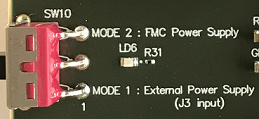7. VLDB+ powering modes¶
In the VLDB+, there are 2 powering modes: The Standalone mode (external) and the FMC mode. As we already said,
the use of the FEASTMP DC/DCs is anyway mandatory in both modes.

Fig. 7.1 SW10 to power the VLDB+¶
To power on the VLDB+ in one of the aforementioned modes, we have to switch the tri-state SW10. Move it to the bottom (MODE 1: External)
to power the VLDB+ in the Standalone mode, move it to the top (MODE 2: FMC) to power the VLDB+ in the FMC mode and move it to the middle
to turn it off.
7.1. Standalone mode¶
In the Standalone mode (referred as Mode 1 on SW10), the VLDB+ is powered through an external power supply.
In this mode, the recommended input voltage supply is 10 V (min 9.5 V, max 12 V).
The supply voltage has to be provided through the 2-pin Phoenix connector (provided with the VLDB+) connected to the J3.
7.1.1. FMC use in Standalone mode¶
In addition, if you connect one or several front-end boards to one or both FMC HPCs (instead of an FPGA evaluation kit) and set
the Standalone mode, the Front-end board(s) will be powered by the VLDB+ (P1V2) through the HPC_VIO_B_M2C pins. You can also connect a Front-end board that
doesn’t require any power just to take out the lpGBT signals. Obviously, connecting front end boards to the FMC
requires a full pin compatibility between the FE board and the VLDB+ (e-links, power, adc, etc). Refer to the Section 13
for more information.
7.2. FMC mode¶
In the FMC mode (referred as Mode 2 on SW10), an external FPGA Evaluation Kit has to be connected on both VLDB+ FMC HPC
connectors to power on the VLDB+.
In this mode, the FEASTMP inputs are being provided with the P12V0_FMC of the FMC standard.
| Evaluation Kit FPGA | Brand |
|---|---|
| VC707 | Xilinx |
| KCU105 | Xilinx |
| VCU108 | Xilinx |
| VCU118 | Xilinx |
| ZCU102 | Xilinx |
Note
Neither other Xilinx models nor Altera brand has been tested with the VLDB+ as they are not supposed to be compatible.
Note
When connecting the EK FPGA together with the VLDB+, please take a look to Section 9.1.1.